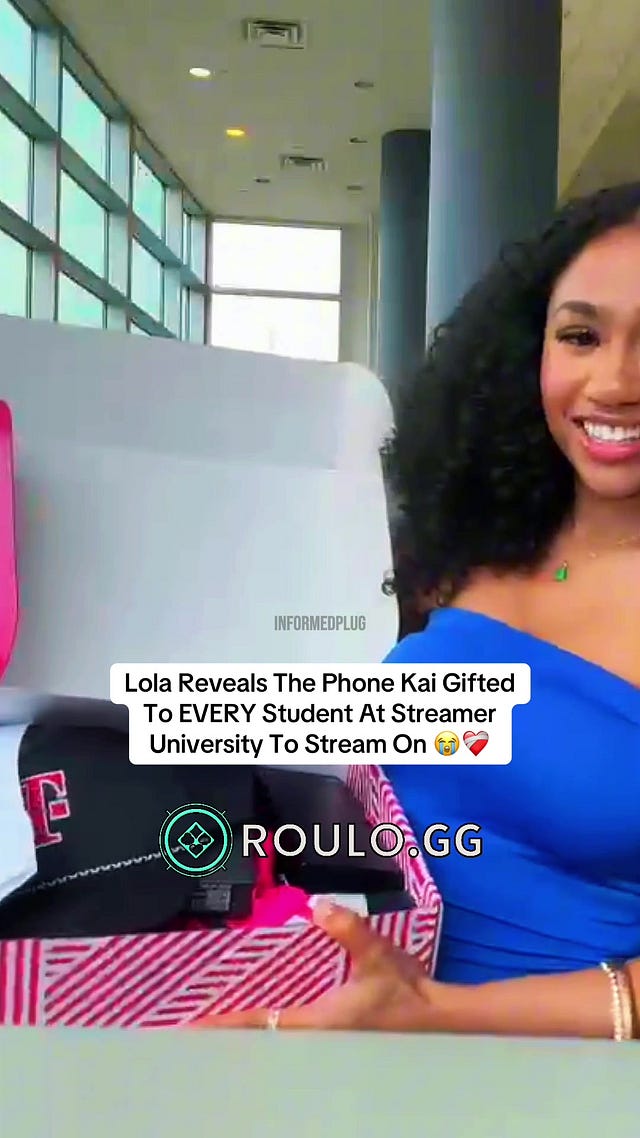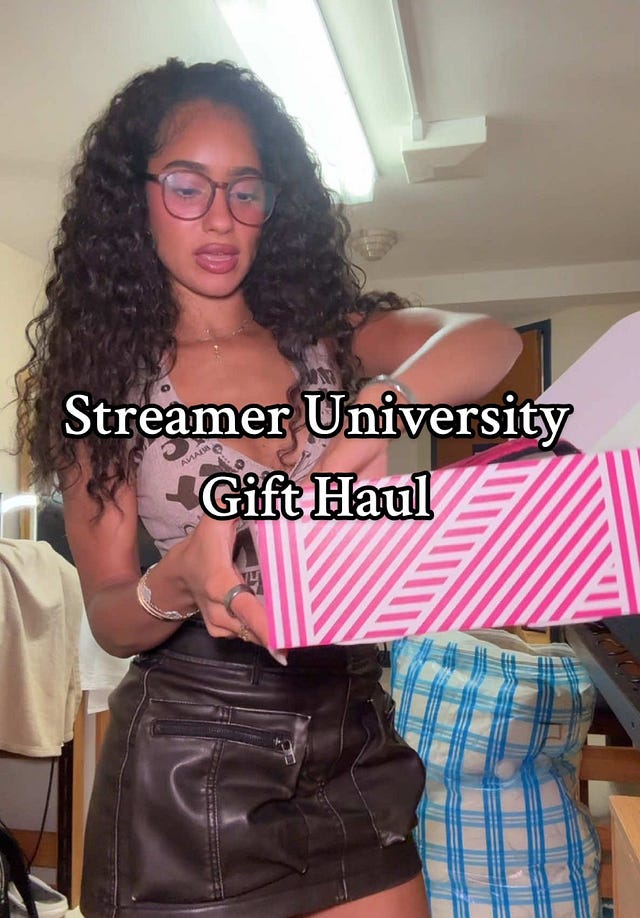Last weekend, Kai Cenat hosted Streamer University at the University of Akron’s campus. It was an experience where 120+ content creators and livestreamers gathered to create content, learn lessons, and engage in various activities in between.
Those who aren’t paying close attention to the livestreaming community may not realize the significance of this event. However, for marketing professionals, culture enthusiasts, and everyone in between, this was a major moment that gives us a glimpse into the future of media (social, paid, digital, etc.).
You might be thinking, “So What?” — so today’s newsletter is your quick recap/breakdown of what happened and why you should care.
Chat, let’s talk about it!
THE BACKGROUND
Kai Cenat had been working on Streamer University for a few months before launch and eventually began making announcements about its creation in early May.
For those hoping to attend, all he asked was that they submit a video application outlining why they deserve one of the coveted spots at the university.
He also announced the instructors for some of his classes, which included popular content creators and streamers such as DDG, CookinWitKya, BenDaDon, Cindy Gallop (an ad industry vet), and many more.
For additional context, according to Kai's stream below, there were over 96,000 applicants to Streamer University; however, some speculate that the actual number of applicants may be over 1 million.
Kai reviews some of the applications in the video below:
THE BRAND PRESENCE
Streamer University also provided a tangible “in” for brands that either had a presence in the streaming space by proxy or were unsure how to approach it.
In particular, at orientation, Kai announced that T-Mobile was gifting each attendee their own Samsung Galaxy S25 Ultra, which they could now use for their content creation and streams.
A move like this likely garnered a good amount of PR, which could eventually bring new customers to the T-Mobile brand — especially those looking for the perfect content creation tools.
Moreover, brands like Tone (owned by AMP!) and Moon Oral Care ended up gifting toiletries to keep everyone fresh on stream, and they even filmed top influencers giving reactions to their content.
Other brands like Béis gave away their signature suitcases, as streamers often travel to create their content.
One of the attendees, Lala (@lalatheislandgirl) does unboxing of the items below - check it out!
THE ENTERTAINMENT FACTOR
A lot of people (especially Millennials and older) wonder what the entertainment factor is for streaming, and the best way I can describe it is by saying that it’s essentially 24/7 improv comedy.
When you look at the happenings of Streamer University, it unfolds like a reality TV show happening in real-time.
Storylines include love triangles (i.e., DDG, India Love, and Duke Dennis), mean-girl gossip, Instructor feuds, parties, and more.
For the old heads, think of it as a Tubi version of A Different World, except the entire series takes place in real-time, and you, as the viewer, are part of the studio audience.
While much of the interactions are contrived, that’s precisely the point.
The content is entertaining because the people in front of the camera are themselves entertaining, and this is proven by who was able to shine at the university.
Don’t let skepticism get in the way — though streamers aren’t as polished as Hollywood actors, they are just as entertaining, if not more.
THE LESSONS LEARNED
Perhaps the greatest part of the university for those who aren’t familiar with the streaming world is Agent 00’s class.
For those who don’t know, Agent is co-founder of the content creation group AMP, which is home to Duke Dennis and Kai Cenat. His class was essentially a 101 on how streamers can create an audience and generate revenue, and a few lessons that apply to those in corporate are:
A. Always Be Brainstorming
Agent says he spends hours every week brainstorming ideas and figuring out what’s next with his team. Sometimes, he does it in his car, other times at home. No matter where he is, though, he’s analyzing his channel, thinking about what performs well, and coming up with engaging content ideas to keep the momentum going.
B. Know Your Numbers
Agent also stressed the importance of knowing your metrics. For many streamers just getting their feet wet, his class helped inform them on how to track their growth and what to charge brands for partnerships. He also gave a primer on when brands typically reach out, how much they pay based on your metrics, and more. Real gems.
THE RESULTS
If you’re reading this and still skeptical about live streaming and where the media industry is moving, the statistics surrounding Streamer University are pretty convincing.
Here are some of the highlights of the 4-day event according to Tubefiller:
27 million hours of watch time (yes, you read that correctly)
719K concurrent viewers
3.57 million unique viewers on the most-watched channel (DDG)
Numbers like these aren’t a fluke — and while botting is a problem in streaming much like it is in general social media, there are not enough bots in the world to account for millions of hours of watch time or the financial benefits that many of the streamers will receive courtesy of their new audiences after attending Streamer U.
That said, several key cultural shifts are highlighted throughout Streamer University.
While it may take time for these to find their way into marketing and advertising, here are a few to be aware of.
THE CULTURAL SHIFT(S)
I. FROM “STATIC POSTING” TO “ALWAYS ON”
The first generation of social media users are accustomed to posting, going away, and waiting for reactions, which can take anywhere from a few minutes to hours or days.
Streamers are at the forefront of the next shift, moving from garnering interest through static posts to creating an environment where the draw is that they’re always “on.”
“Always on” entertainment creates a level of accessibility that wasn’t available in earlier iterations of social media. And now, with IRL setups, Gen Z’ers are going live (in crystal clear clarity) from wherever they are, and interacting with fans in real-time. THEN they follow up with static posts/reels that recap the live experience.
II. FROM “CULTIVATING FOLLOWERS” TO “CULTIVATING DISCOVERY”
An essential lesson from Agent’s class and Duke Dennis speaking to students is how the funnel works for many streamers.
In many cases, they post three to four times a day to capture their audience's interest. In all their conversations about building their Twitch channels, the focus is purely on discovery, as followers are just seen as a byproduct of maintaining a high posting frequency.
To fuel discovery in their world, everything comes back to clips that they use from their streams for discovery on TikTok or YouTube Shorts, and those two platforms eventually push viewers to Twitch (there’s a whole economy around clipping, but we’ll save that for another day).
III. FROM “REVIEWS TO “REACTIONS”
Another interesting phenomenon that I noticed while watching clips of Streamer Univeristy is that Twitch streamers were reacting to events that happened in other streams (sometimes while in the building with each other).
It’s lowkey inception at times, but it does highlight something interesting: a shift is taking place from reviews (again, a very Millennial-esque concept) to reactions.
Reactions are more or less the same, but unlike reviews, they aren’t presented in a way that feels well-thought-out and mindful of the audience so as not to offend a brand.
Contrarily, reaction content is an in-the-moment “how this made me feel” type of vibe — the reactor couldn’t hide their true feelings even if they wanted to, which makes the viewing experience all the richer.
IV. FROM “LIVED EXPERIENCE” TO “LIVING VICARIOUSLY”
There’s a skepticism that older generations have around streaming, which usually manifests in the question, “Why would I want to watch someone just sit around and talk for hours?”
And it’s a fair question — many of us reading this remember life before social media and even before the internet.
However, as we often say in our industry, this generation is the first digitally native one; they grew up on Google, sharing personal truths online and engaging in ridiculous pranks for likes.
This is their natural environment.
And with third spaces all but gone, the only logical place where they can still keep in touch with their friends and meet new people is online.
Lastly…
For those of us who grew up before Gen Z, let me remind you that many of us watched vlogs from our favorite artists and creators as they rose to fame. This is essentially the same thing, except at a faster rate & less produced.
In a sense, viewers aren’t just spectators; being in the moment as it occurs makes you a part of the moment as if you were there. Ergo, viewers don’t have actually to live the moment because they lived it through the streamer.
SO, WHAT NOW?
I’m not gone hold you.
The ad industry is behind, like waaaaay behind on what’s going on out here.
That’s somewhat to be expected. But by and large, if you’ve got the bandwidth (corporate jargon, ha), you should probably look at this space a little closer — the next frontier isn’t approaching; it’s here.
Who knows? Soon, SNOBHOP may be on Twitch.
Chat, let me know if you’re rocking with that.
One.






